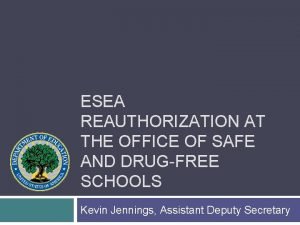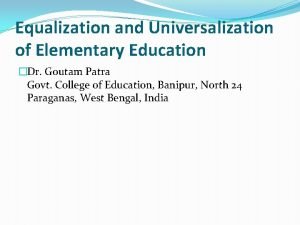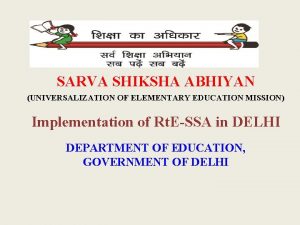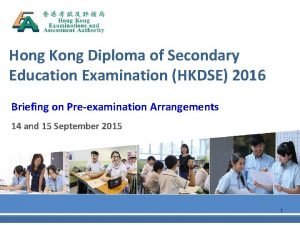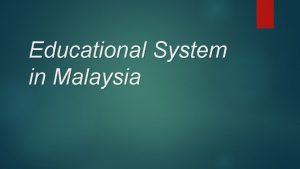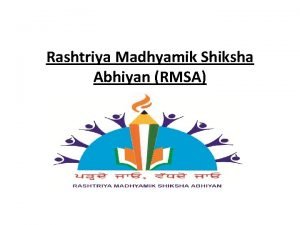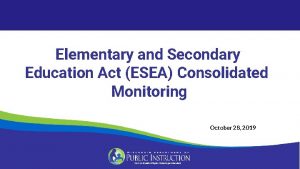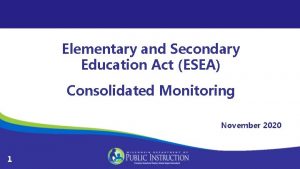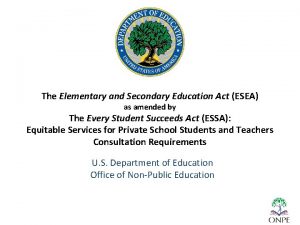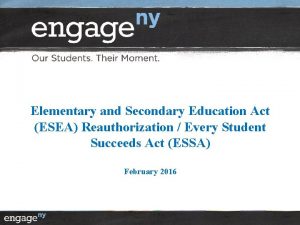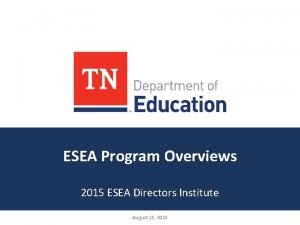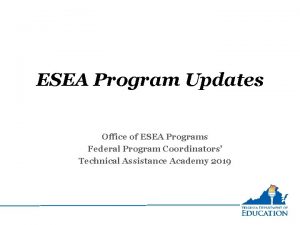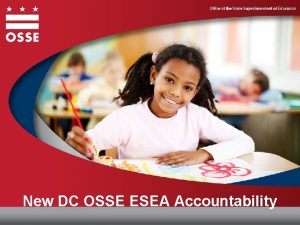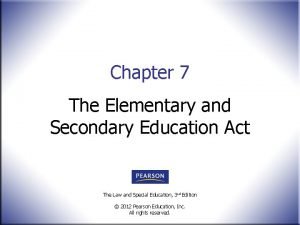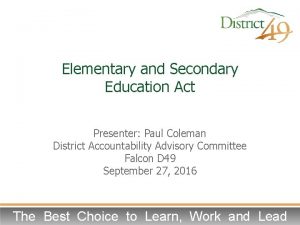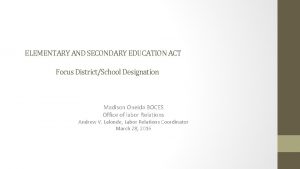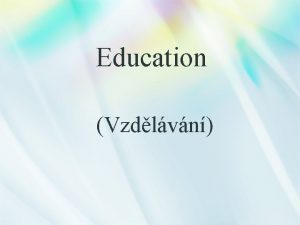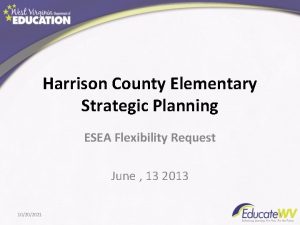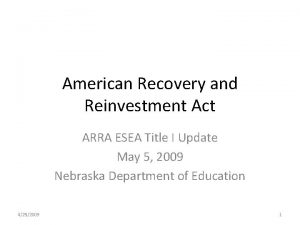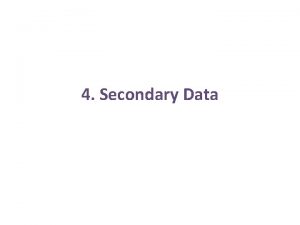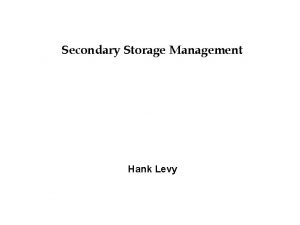THE ELEMENTARY AND SECONDARY EDUCATION ACT ESEA AS

























































- Slides: 57

THE ELEMENTARY AND SECONDARY EDUCATION ACT (ESEA) AS AMENDED BY THE EVERY STUDENT SUCCEEDS ACT (ESSA) CHANGES TO THE EQUITABLE SERVICES REQUIREMENTS Office of Non-Public Education (ONPE) U. S. Department of Education

Objectives Participants will gain: Understanding of new and changed provisions under the Elementary and Secondary Education Act (ESEA), as amended by the Every Student Succeeds Act (ESSA), as they apply to equitable services. Knowledge of resources to assist you in understanding current and new provisions that need to be implemented, monitored, and enforced. http: //innovation. ed. gov/what-we-do/non-public-education/ 2

Agenda Background information and overview of Office of Non-Public Education New and changed provisions under the ESEA, as amended by the ESSA that apply to Title I, Part A and Title VIII (Title IX under NCLB) New and changed provisions specific to Title I, Part A New and changed provisions specific to Title VIII http: //innovation. ed. gov/what-we-do/non-public-education/ 3

Elementary and Secondary Education Act (ESEA) Since the passage of the ESEA in 1965, local educational agencies (LEAs) have been required to provide equitable services to private school students, teachers, and, in some cases, other education personnel and parents under a number of the ESEA programs. http: //innovation. ed. gov/what-we-do/non-public-education/ 4

Where to find the Provisions On December, 10, 2015 the Every Student Succeeds Act, amending the Elementary and Secondary Education Act of 1965 (ESEA), was signed into law. The ESEA as amended by No Child Left Behind (NCLB) remains in effect through the 2016 -2017 school year. The ESSA strengthens and enhances the equitable services provisions and provides for more State and district level accountability. Visit the ONPE website to see a comparison chart of the equitable services provisions. No Child Left Behind Act Remains in effect through 2016 -2017 school year. ESSA equitable services provisions go into effect in 2017 -2018 school year. Equitable Services provisions found in Section 1120 Equitable Services provisions found in Section 1117 Title IX (Uniform Provisions) found under Sections 9501 -9504 Equitable services provisions found under Sections 8501 -8504 (Title VIII Uniform Provisions) http: //innovation. ed. gov/what-we-do/non-public-education/ 5

Non-Regulatory Guidance Department issued non-regulatory guidance on equitable services requirements under the ESEA, as amended by the ESSA, on November 21, 2016. Except as otherwise provided in the guidance, the existing non-regulatory guidance documents remain applicable: Title I Services to Eligible Private School Children, issued on Oct. 17, 2003, and available at: http: //www 2. ed. gov/programs/titleiparta/psguidance. doc; and Title IX, Part E Uniform Provisions, Subpart 1—Private Schools, revised on Mar. 2009 and available at: http: //www 2. ed. gov/policy/elsec/guid/equitablesergui dance. doc. http: //innovation. ed. gov/what-we-do/non-public-education/ 6

TIPS ON USING THE NEW GUIDANCE Primarily focuses on requirements that are new or changed that are common to Title I and Title VIII and those that are specific to Title I and Title VIII. Intended for use in conjunction with existing guidance documents that are referenced (see previous slide). Additional comprehensive guidance on specific topics that will cover new and unchanged requirements is planned. http: //innovation. ed. gov/what-we-do/non-public-education/ 7

http: //innovation. ed. gov/what-we-do/non-public-education/ 8

COMMON EQUITABLE SERVICES REQUIREMENTS UNDER TITLE I, PART A AND TITLE VIII, PART F http: //innovation. ed. gov/what-we-do/non-public-education/ 9

Ombudsman Statute - New Requirement To help ensure that private school children, teachers, and other educational personnel receive services equitable to those in public schools, State educational agencies (SEAs) must designate an ombudsman to monitor and enforce Title I and Title VIII equitable services requirements. ESEA sections 1117(a)(3)(B) and 8501(a)(3)(B) FAQs N-1 through N-5 http: //innovation. ed. gov/what-we-do/non-public-education/ 10

Ombudsman Guidance - Roles and Responsibilities • • • The ombudsman should: Serve as an SEA’s primary point of contact for addressing questions and concerns from private school officials and LEAs regarding the provision of equitable services under Titles I and VIII. Monitor and enforce the equitable services requirements under Titles I and VIII and, thus, should have a significant role in the State’s monitoring process. Ensure that private school officials know how to contact the ombudsman. http: //innovation. ed. gov/what-we-do/non-public-education/ 11

Ombudsman Guidance - Monitoring and Enforcement The primary responsibilities of an ombudsman are to monitor and enforce the equitable services requirements in Titles I and VIII. An ombudsman should work with SEA staff administering Title I and programs covered under Title VIII to develop monitoring protocols applicable to the provision of equitable services under each program. The ombudsman should also serve as the primary point of contact for responding to and resolving any complaints regarding equitable services that the SEA receives under its ESEA complaint procedures. http: //innovation. ed. gov/what-we-do/non-public-education/ 12

Ombudsman Guidance - Qualifications An SEA has discretion in determining who to designate as an ombudsman. In determining the relevant qualifications of the ombudsman position, an SEA should consult with appropriate private school officials. An SEA should consider the following factors in determining who will serve as an ombudsman: Knowledge Capacity Impartiality http: //innovation. ed. gov/what-we-do/non-public-education/ 13

Ombudsman Guidance - Funds to Support If an SEA consolidates State administrative funds under the ESEA section 8201, it may support its ombudsman using those funds. If an SEA does not consolidate State administrative funds, it nonetheless may support its ombudsman using funds reserved for State administration under Title I and the covered programs under the ESEA section 8501(b). Under these circumstances, however, the SEA must ensure that the ombudsman’s salary is charged to each program based on the relative benefit received. (2 CFR § 200. 405(a). ) http: //innovation. ed. gov/what-we-do/non-public-education/ 14

Ombudsman Guidance - Implementation Timeline An LEA must consult with private school officials to plan for the 2017− 2018 school year before it makes any decision that affects the opportunity of eligible private school children, their teachers, and their families to participate in Title I or covered programs under Title VIII. An SEA should designate an ombudsman in sufficient time to be of assistance as LEAs and private school officials begin the consultation process for the 2017− 2018 school year, which would generally occur in the late winter/early spring of 2017. http: //innovation. ed. gov/what-we-do/non-public-education/ 15

Obligation of Funds Statute - New Requirement Funds allocated to an LEA for educational services and other benefits to eligible private school children, teachers and other educational personnel, and families must be obligated in the fiscal year for which the funds are received by the LEA. ESEA sections 1117(a)(4)(B) and 8501(a)(4)(B) FAQs N-6 through N-7 http: //innovation. ed. gov/what-we-do/non-public-education/ 16

Obligation of Funds Guidance - Purpose This provision helps to ensure that an LEA uses the funds available under Title I or a program covered under Title VIII to provide equitable services in the fiscal year for which the funds were appropriated so that eligible students, teachers and other educational personnel, and families receive the services to which they are entitled in a timely manner. This provision reinforces the requirement that an LEA conduct timely consultation with private school officials to design appropriate equitable services so that those services can begin at the beginning of the school year for which the funds are appropriated. http: //innovation. ed. gov/what-we-do/non-public-education/ 17

Obligation of Funds Guidance - Carryover Permissibility In general, an LEA must obligate the funds allocated for equitable services under all applicable programs in the year for which they are appropriated. There may be extenuating circumstances in which an LEA is unable to obligate all funds within this timeframe in a responsible manner. Under these circumstances, the funds may remain available for the provision of equitable services under the respective program during the subsequent school year. In determining how such carryover funds will be used, the LEA must consult with appropriate private school officials. http: //innovation. ed. gov/what-we-do/non-public-education/ 18

Notice of Allocation Statute - New Requirement An SEA must provide notice in a timely manner to appropriate private school officials in the State of the allocation of funds for educational services and other benefits under each ESEA program that an LEA has determined are available for eligible private school children, teachers and other educational personnel, and families. ESEA sections 1117(a)(4)(C) and 8501(a)(4)(C) FAQs N-8 through N-10 http: //innovation. ed. gov/what-we-do/non-public-education/ 19

Notice of Allocation Guidance – Notice to Private School officials An SEA must annually provide information on the amount of funds, by program, allocated for equitable services that each LEA responsible for providing equitable services has determined are available for eligible private school students, teachers and other educational personnel, and families. This applies to Title I (including the amount for parental involvement) and each covered program under the ESEA section 8501(b). Such documentation should indicate how the allocation was determined. http: //innovation. ed. gov/what-we-do/non-public-education/ 20

Notice of Allocation Guidance - How to Disseminate Notice of Allocation An SEA should consult with appropriate private school officials to determine an effective manner for disseminating the notice of allocation to appropriate private school officials, which may include notification through the ombudsman. An SEA may consider methods such as publicly posting this information on the SEA’s website, using an email distribution list of private school officials, or other methods that will ensure that this information is available to appropriate private school officials. http: //innovation. ed. gov/what-we-do/non-public-education/ 21

Notice of Allocation Guidance - When to Disseminate Notice of Allocation An SEA should consult with LEAs and appropriate private school officials to determine a reasonable timeline for providing the notice of allocation. In general, an SEA should ensure that the notice is provided prior to the beginning of the school year. http: //innovation. ed. gov/what-we-do/non-public-education/ 22

Compliance - State Services Statute - New Requirement An SEA must provide equitable services directly or through contracts with public or private agencies, organizations, or institutions, if appropriate private school officials have — – – Requested that the SEA provide such services directly; and Demonstrated that an LEA has not met applicable equitable services requirements in accordance with the procedures for making such a request, as prescribed by the SEA. ESEA sections 1117(b)(6)(C) and 8501(c)(6)(C) FAQs N-11 and N-12 http: //innovation. ed. gov/what-we-do/non-public-education/ 23

Compliance - State Services Guidance - Procedures Governing Request An SEA should consult with appropriate private school officials in developing procedures under which private school officials may request the SEA to provide equitable services in lieu of an LEA. Most instances of non-compliance with equitable services requirements likely can be corrected with minimal intervention by the SEA. An SEA might develop procedures that require private school officials to demonstrate that an LEA has substantially failed or is unwilling to provide equitable services before the SEA intervenes. An SEA should make available a standard template for requests and have transparent procedures for evaluating such requests. http: //innovation. ed. gov/what-we-do/non-public-education/ 24

Consultation Statute - New Requirement The goal of consultation is agreement between the LEA and appropriate private school officials on how to provide equitable and effective programs for eligible private school children. ESEA sections 1117(b)(1) and 8501(c)(1) FAQ N-13 http: //innovation. ed. gov/what-we-do/non-public-education/ 25

School Choice Participation in a Federal or State private school choice program does not affect a private school student’s eligibility for equitable services under an ESEA program. Regardless of the source of funds paying a private school student’s tuition, a student is eligible for equitable services under the ESEA if the student meets the eligibility requirements of the respective program. http: //innovation. ed. gov/what-we-do/non-public-education/ 26

EQUITABLE SERVICES REQUIREMENTS UNDER TITLE I http: //innovation. ed. gov/what-we-do/non-public-education/ 27

Allocating for Services Statute. Funds - Change to Equitable Existing Requirement Expenditures for equitable services to eligible private school children, teachers and other educational personnel, and families must be equal to the proportion of funds allocated to participating public school attendance areas based on the number of children from low-income families who reside in those attendance areas and attend private schools. An LEA must determine the proportionate share of Title I funds available for equitable services based on the total amount of Title I funds received by the LEA prior to any allowable expenditures or transfers of funds. Section 1117(a)(4)(A) FAQs O-1 to O-5 http: //innovation. ed. gov/what-we-do/non-public-education/ 28

Allocating Funds for Equitable Services Guidance - Reservations An LEA must determine the amount of funds available for providing equitable services prior to any expenditures or transfers of funds. This includes all reservations previously taken “off the top” of an LEA’s Title I allocation, including reservations for administration, parental involvement, and district-wide initiatives. http: //innovation. ed. gov/what-we-do/non-public-education/ 29

Allocating Funds for Equitable Services Guidance –Proportionate Share An LEA would determine the proportionate share of Title I funds available for equitable services as follows: 1. Determine the total number of children from lowincome families residing in each participating public school attendance area who attend public and private schools. 2. Determine the overall proportion of these children who attend private schools. 3. Based on this proportion, determine the amount of funds available for equitable services based on that proportion of the LEA’s total Title I allocation. http: //innovation. ed. gov/what-we-do/non-public-education/ 30

Allocating Funds for Equitable Services Guidance –Proportionate Share EXAMPLE OF DETERMINING THE AMOUNT OF TITLE I FUNDS FOR EQUITABLE SERVICES CHART Public School Attendance Area Number of Public School Low-Income Children Number of Private School Low-Income Children A 500 120 620 B 300 9 309 C 200 6 206 D 350 15 365 1, 350 1, 500 90% $900, 000 10% $100, 000 TOTAL PROPORTIONATE SHARE http: //innovation. ed. gov/what-we-do/non-public-education/ Total Number of Low-Income Children 31

Allocating Funds for Equitable Services Guidance – administering equitable services From the proportionate share of Title I funds available to provide equitable services, an LEA may reserve an amount that is reasonable and necessary to administer equitable services. An LEA determines this amount separately from the funds needed to administer the Title I program for students in public schools. The LEA should discuss administrative costs for implementing equitable services during consultation with appropriate private school officials. http: //innovation. ed. gov/what-we-do/non-public-education/ 32

Allocating Funds for Equitable Services Guidance – Parental and Family Engagement Funds An LEA must reserve and spend at least 1 percent of its Title I allocation for parent and family engagement activities if the LEA’s Title I allocation exceeds $500, 000. To determine this amount, an LEA must calculate 1 percent of its total Title I allocation. The LEA then applies the proportionate share percentage for services to private school students to determine how much it must spend for parent and family engagement activities for the families and parents of eligible private school students. The LEA must then spend that amount from the proportion of its Title I allocation available for equitable services for private school students. http: //innovation. ed. gov/what-we-do/non-public-education/ 33

Allocating Funds for Equitable Services Guidance – Parental and Family Engagement Funds EXAMPLE OF EQUITABLE SERVICES FOR PARENTS AND FAMILIES OF ELIGIBLE PRIVATE SCHOOL CHILDREN CHART LEA’s Title I allocation 1% for parent and family engagement Proportionate share for equitable services for parents and families (based on example under question O-4) Source of funds for equitable services for parents and families (proportionate share under question O-4 = $100, 000) $1, 000 $10, 000 $1, 000 ($10, 000 x 10%) $100, 000 -$1, 000=$99, 000 remaining for instruction and professional development http: //innovation. ed. gov/what-we-do/non-public-education/ 34

Transmitting Agreement on Consultation to the Ombudsman Statute and Guidance – New Requirement The results of agreement following consultation must be transmitted to the SEA’s equitable services ombudsman. The ombudsman should establish a process for receiving documentation of agreement from each LEA. For example, the ombudsman may direct an LEA to document agreement on the same form the LEA uses to document affirmation of consultation and submit that form to the ombudsman. Section 1117(b)(1) FAQ O-5 http: //innovation. ed. gov/what-we-do/non-public-education/ 35

Consultation Statute – Changes to Existing Requirements The list of consultation topics has been expanded to include: How the proportionate share of funds is determined; Whether services will be provided directly or through a separate government agency, consortium, entity, or third-party contractor; Whether to pool funds for equitable services; When, including the approximate time of day, services will be provided; and Whether to consolidate Title I equitable services funds with funds available for services to private school children under other ESEA programs. Section 1117(b)(1) FAQs O-6 and O-7 http: //innovation. ed. gov/what-we-do/non-public-education/ 36

Consultation Statute – Changes to Existing Requirements Other changes related to consultation: The written affirmation that consultation has occurred must provide the option for private school officials to indicate that such officials’ belief that timely and meaningful consultation has not occurred or that the program design is not equitable with respect to eligible private school children. Section 1117(b)(1) FAQs O-6 and O-7 http: //innovation. ed. gov/what-we-do/non-public-education/ 37

Consultation Guidance – Options for Providing Title I Equitable Services The option to either pool funds for multiple private schools or provide services on a school-by-school basis is unchanged. The only change is that the statute now specifies that an LEA must consult with private school officials regarding these options. http: //innovation. ed. gov/what-we-do/non-public-education/ 38

Consultation Guidance – Consolidating and Using Funds in Coordination with Other Programs As part of consultation, an LEA must consider whether to consolidate and use Title I funds to provide equitable services under Title I in coordination with funds for equitable services from programs covered under Title VIII. For example, through coordination, an LEA with limited available funds might use Title I funds to provide instructional services to Title I-eligible private school students; use Title II funds to provide professional development to those students’ teachers (as opposed to all teachers in a given school); use Title III funds to improve the English proficiency of English learners among the participating students; and use Title IV funds to provide necessary counseling services to the most-at risk eligible students. http: //innovation. ed. gov/what-we-do/non-public-education/ 39

Consultation Guidance – Consolidating and Using Funds in Coordination with Other Programs In coordinating Title I equitable services with other programs, funds would continue to be used for allowable activities under each program, but the coordinated services would allow the LEA to better serve the needs of the most at-risk students in comprehensive manner. Coordination between programs will eliminate the silo approach through which an LEA consults with private school officials on a program-by-program basis. http: //innovation. ed. gov/what-we-do/non-public-education/ 40

EQUITABLE SERVICES REQUIREMENTS UNDER TITLE VIII http: //innovation. ed. gov/what-we-do/non-public-education/ 41

Covered Programs Statute- Change to Existing Requirement The ESSA updated the covered programs to include the following: – Title I, Part C – Education of migratory children – Title II, Part A - Supporting Effective Instruction – Title III, Part A - English Language Acquisition, Language Enhancement, and Academic Achievement – Title IV, Part A - Student Support and Academic Enrichment Grants – Title IV, Part B - 21 st Century Community Learning Centers ESEA section 8501(b) http: //innovation. ed. gov/what-we-do/non-public-education/ 42

Complaint Process Statute- Change to Existing Requirement The timeframe that an SEA has for responding to a complaint from parents, teachers, or other individuals concerning violations of the ESEA section 8501 regarding the participation by private school children and teachers is 45 days. In addition, the Secretary must investigate and resolve an appeal of an SEA’s resolution of a complaint within 90 days. ESEA section 8503 http: //innovation. ed. gov/what-we-do/non-public-education/ 43

Consultation Statute- Changes to Existing Requirement In addition to the topics currently subject to consultation under NCLB, topics have been expanded to include the following: How the proportionate share of funds is determined; Whether services will be provided directly or through a separate government agency, consortium, entity or third-party contractor; and Whether to provide equitable services by pooling or on a school-byschool basis. LEAs now are also required to maintain and provide to the SEA a written affirmation that consultation has occurred signed by private school representatives. ESEA section 8501(c) FAQ P-1 http: //innovation. ed. gov/what-we-do/non-public-education/ 44

CONSULTATION - Title VIII Needs of Private School Students and Teachers NEW December How & When Decisions are Made November Amount of Funds Available for Services October Size and Scope of Services Offered and Delivery of Services September 3 rd Party Providers August Assessment of Services January Timely and meaningful consultation must continue throughout the implementation and assessment of services and shall occur before the local education agency makes any decision that affects the opportunities to participate of eligible private school students, teachers, and other education personnel. July http: //innovation. ed. gov/what-we-do/non-public-education/ Pooling of Funds February March Providing Services Directly or Via Another Entity How Amount of Funding is Determined April Requires Written Affirmation May June 45

Consultation Guidance – Options for Providing Equitable Services An LEA may still expend funds for equitable services on a school-byschool basis or by pooling. * The statute now specifically requires an LEA to consult with private school officials regarding these options. *See the previous Title IX Uniform Provisions Non-regulatory guidance, FAQ F-10, for an explanation of pooling. http: //innovation. ed. gov/what-we-do/non-public-education/ 46

Title II, Part A Allocation Statute – Change to Existing Requirement Removed: The provisions in section 9501(b)(3) of the ESEA, as amended by NCLB, that limit the equitable services requirements that apply to LEAs’ use of Title II, Part A funds to those funds used by the LEA to provide professional development to teachers and others. ESEA section 8501(b) FAQs P-2 through P-4 http: //innovation. ed. gov/what-we-do/non-public-education/ 47

Title II, Part A Allocation Guidance – Calculating the Equitable Services Allocation The equitable services allocation for Title II, Part A must be calculated on the basis of the LEA’s total Title II, Part A allocation. Administrative costs are still taken “off the top”. The LEA’s equitable services allocation is determined by first calculating the amount of Title II, part A funds available on a per-pupil basis, based on the total of all public and private school students (enrolled in participating private elementary and secondary schools), in areas served by the LEA- regardless of a student’s residency. This amount is then multiplied by the number of students enrolled in participating private schools. http: //innovation. ed. gov/what-we-do/non-public-education/ 48

Title II, Part A Allocation Guidance – Calculating the Equitable Services Allocation EXAMPLE OF FORMULA TO DETERMINE AMOUNT FOR TITLE II, PART A EQUITABLE EXPENDITURES CHART A. Number of Students A 1: LEA Enrollment 900 A 2: Participating Private Schools Enrollment 100 A 3: Total Enrollment = A 1 + A 2 1, 000 B. Title II, Part A Allocation B 1: Total LEA Allocation B 2: Administrative Costs (for public and private school programs) B 3: LEA Allocation Minus Admin Costs = B 1 -B 2 $1, 000 $50, 000 $950, 000 C. Per Pupil Rate C 1: B 3 divided by A 3 $950 D. Equitable Services Amount LEA must reserve for equitable services for private school teachers and other educational personnel = A 2 x C 1 http: //innovation. ed. gov/what-we-do/non-public-education/ $95, 000 49

Title II, Part A Activities Guidance – Permissible Uses of Funds for Equitable Services Title II, Part A funds may still be used for professional development activities for teachers, instructional leadership teams, principals, and other school leaders to address the specific needs of their students and is in accordance with the purposes of Title II. Equitable services under Title II, Part A may still not be used for class-size reduction in a private school because a private school’s contracts for its teachers and staff would be inconsistent with the requirements in ESEA section 8501(d) regarding public control of funds and the supervision and control of employees or contractors. http: //innovation. ed. gov/what-we-do/non-public-education/ 50

Title II, Part A Activities Guidance – Permissible Uses of Funds for Equitable Services There may now be other permissible uses of funds. All services provided for the benefit of private school participants must: Be an allowable use of funds under statute; Meet the specific needs of students enrolled in the private school, not the school itself; Must be provided by either an employee of the public agency or through a contract by the public agency with an individual, association, agency, or organization who must be independent of the private school and any religious organization. All contracts must be under control and supervision of the public agency; and All funds must remain in control of the public agency responsible for providing equitable services. http: //innovation. ed. gov/what-we-do/non-public-education/ 51

Title II, Part A Activities Use of funds under Title II, Part A section 2103(b)(3)(E): The programs and activities described in this section may include, among other programs and activities, providing high-quality, personalized professional development that is evidence-based, to the extent the State determines that such evidence is reasonable available, for teachers, instructional leadership teams, principals, or other school leaders, that is focused on improving teaching and student learning and achievement… Title II, Part A Non-Regulatory Guidance http: //innovation. ed. gov/what-we-do/non-public-education/ 52

Title II, Part A State Activities Guidance – Calculation of Funds for State-level Activities The SEA has the responsibility to implement equitable services to the extent that it reserves any funds under ESEA section 2101(c)(1) for State-level activities authorized in sections 2101(c)(3)-(4). The amount of an SEA must reserve for equitable services is calculated on the basis of the per-pupil amount of Title II, Part A funds the SEA reserves for all of its State-level activities, taking into consideration all public and private school students in the area of the State to be served (ESEA section 8501(a)(4)(A)). State-level activities in which private school teachers may participate must be determined in consultation between the SEA and appropriate private school representatives. http: //innovation. ed. gov/what-we-do/non-public-education/ 53

Questions? http: //innovation. ed. gov/what-we-do/non-public-education/ 54

Resources ESSA Guidance Non-Regulatory Guidance: Fiscal Changes and Equitable Services Requirements Non-Regulatory Guidance for Title II, Part A: Building Systems of Support for Excellent Teaching and Leading Non-Regulatory Guidance: English Learners and Title III of the Elementary and Secondary Education Act as amended by the Every Student Succeeds Act Non-Regulatory Guidance Student Support and Academic Enrichment Grants (Title IV, Part A) Key ESSA Resources available at: http: //www 2. ed. gov/policy/elsec/leg/essa/index. html http: //innovation. ed. gov/what-we-do/non-public-education/ 55

Resources NCLB Guidance Title III, Part A Equitable Services to Private School Students, Teachers, and Other Educational Personnel Non-Regulatory Guidance (July 2015) Title IX, Part E Uniform Provisions Equitable Services for Eligible Private School Students, Teachers, and Other Educational Personnel Non. Regulatory Guidance (March 2009) http: //innovation. ed. gov/what-we-do/non-public-education/ 56

For more information on equitable services and other Federal programs available to private school students and teachers: See our website: http: //innovation. ed. gov/what-we-do/non-public-education/ Email: ONPE@ed. gov Call: 202 -401 -1365 Write: U. S. Department of Education 400 Maryland Ave SW Washington DC 20202 http: //innovation. ed. gov/what-we-do/non-public-education/ 57
 Is esea safe
Is esea safe Macbeth summary
Macbeth summary Post secondary education training and labour
Post secondary education training and labour Universalization of retention
Universalization of retention Role of ssa in universalisation of elementary education
Role of ssa in universalisation of elementary education Csun elementary education
Csun elementary education Hát kết hợp bộ gõ cơ thể
Hát kết hợp bộ gõ cơ thể Bổ thể
Bổ thể Tỉ lệ cơ thể trẻ em
Tỉ lệ cơ thể trẻ em Gấu đi như thế nào
Gấu đi như thế nào Glasgow thang điểm
Glasgow thang điểm Chúa yêu trần thế alleluia
Chúa yêu trần thế alleluia Các môn thể thao bắt đầu bằng tiếng nhảy
Các môn thể thao bắt đầu bằng tiếng nhảy Thế nào là hệ số cao nhất
Thế nào là hệ số cao nhất Các châu lục và đại dương trên thế giới
Các châu lục và đại dương trên thế giới Công của trọng lực
Công của trọng lực Trời xanh đây là của chúng ta thể thơ
Trời xanh đây là của chúng ta thể thơ Mật thư anh em như thể tay chân
Mật thư anh em như thể tay chân Phép trừ bù
Phép trừ bù Phản ứng thế ankan
Phản ứng thế ankan Các châu lục và đại dương trên thế giới
Các châu lục và đại dương trên thế giới Thơ thất ngôn tứ tuyệt đường luật
Thơ thất ngôn tứ tuyệt đường luật Quá trình desamine hóa có thể tạo ra
Quá trình desamine hóa có thể tạo ra Một số thể thơ truyền thống
Một số thể thơ truyền thống Cái miệng nó xinh thế chỉ nói điều hay thôi
Cái miệng nó xinh thế chỉ nói điều hay thôi Vẽ hình chiếu vuông góc của vật thể sau
Vẽ hình chiếu vuông góc của vật thể sau Biện pháp chống mỏi cơ
Biện pháp chống mỏi cơ đặc điểm cơ thể của người tối cổ
đặc điểm cơ thể của người tối cổ Ví dụ về giọng cùng tên
Ví dụ về giọng cùng tên Vẽ hình chiếu đứng bằng cạnh của vật thể
Vẽ hình chiếu đứng bằng cạnh của vật thể Tia chieu sa te
Tia chieu sa te Thẻ vin
Thẻ vin đại từ thay thế
đại từ thay thế điện thế nghỉ
điện thế nghỉ Tư thế ngồi viết
Tư thế ngồi viết Diễn thế sinh thái là
Diễn thế sinh thái là Các loại đột biến cấu trúc nhiễm sắc thể
Các loại đột biến cấu trúc nhiễm sắc thể Các số nguyên tố là gì
Các số nguyên tố là gì Tư thế ngồi viết
Tư thế ngồi viết Lời thề hippocrates
Lời thề hippocrates Thiếu nhi thế giới liên hoan
Thiếu nhi thế giới liên hoan ưu thế lai là gì
ưu thế lai là gì Hổ sinh sản vào mùa nào
Hổ sinh sản vào mùa nào Khi nào hổ mẹ dạy hổ con săn mồi
Khi nào hổ mẹ dạy hổ con săn mồi Sơ đồ cơ thể người
Sơ đồ cơ thể người Từ ngữ thể hiện lòng nhân hậu
Từ ngữ thể hiện lòng nhân hậu Thế nào là mạng điện lắp đặt kiểu nổi
Thế nào là mạng điện lắp đặt kiểu nổi World in 100 years
World in 100 years Mudaliar commission objectives
Mudaliar commission objectives Bureau of secondary education
Bureau of secondary education Hkdse certificate issue date
Hkdse certificate issue date Malaysian national secondary schools are subdivided into
Malaysian national secondary schools are subdivided into Structure and function of community in pakistan
Structure and function of community in pakistan Uon education secondary
Uon education secondary Components of rmsa
Components of rmsa Secondary engagement programme
Secondary engagement programme Venn diagram formal education and nonformal education
Venn diagram formal education and nonformal education
